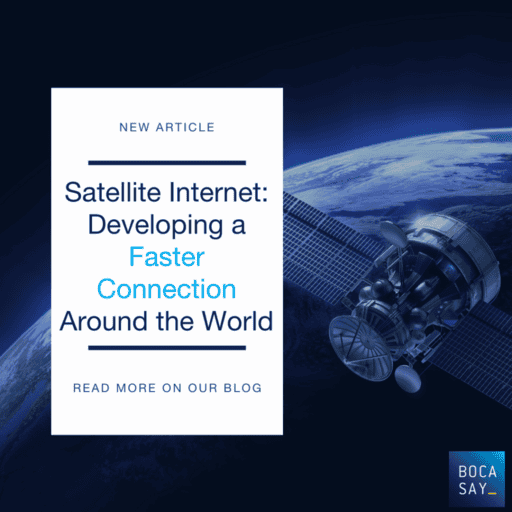Satellite Internet: Developing a Faster Connection Around the World
Satellite communications, currently used in some sectors, could be the next big thing in the telecommunications industry. What is the “space internet”? Why will it become important in the near future?
Technology has brought us fantastic tools like smartphones and computers, and has allowed us to accomplish incredible feats, like taking our first steps on the moon. But what do the internet and space have in common, you may ask?
In this article, our offshore esn examines the basics of the space internet, the different stakes, actors and benefits related to this innovation.

What is Satellite Internet?
The high seas, mountain peaks, and the heart of the desert are the goals of the space Internet, which must be able to serve regions without fiber optics or terrestrial infrastructure to carry signals.
To make it work, thousands of low-cost satellites are deployed in orbit around the earth. However, they differ from geostationary satellites, which are more commonly used in satellite internet.
By deploying 5G connectivity via satellites in low earth orbit, extreme geographic regions or remote areas will benefit from high-speed network coverage.
How does it work?
Space-based internet is actually not that different from satellite-based internet. Every time you surf the Internet, your satellite dish sends request data to satellites located 36,000 km above sea level.
The satellite transmits to a transmitting/receiving station belonging to the internet operator you have chosen. Once the page is retrieved, the station sends the data back to the satellite so that it can display the desired page. This is a journey of about 140,000 kilometers!
Such a distance causes latency between the request and the response, which providers are working hard to reduce. This is where the innovation of the space internet comes in.
Instead of sending satellites 36,000 km away, we are talking about sending them into low orbit. Smaller devices, and therefore more numerous, allowing to reduce the time of result, but also to cover the whole globe.
The satellites in low orbit make it possible to broadcast the Internet much more quickly. These small stellar armies are called constellations (in relation to their resemblance with the formation of real constellations seen from the Earth).
𝔻𝕖𝕧𝕖𝕝𝕠𝕡 𝕪𝕠𝕦𝕣 𝕠𝕟𝕝𝕚𝕟𝕖 𝕓𝕦𝕤𝕚𝕟𝕖𝕤𝕤 𝕨𝕚𝕥𝕙 𝕥𝕙𝕖 𝕓𝕖𝕤𝕥 𝕥𝕖𝕔𝕙𝕟𝕚𝕔𝕚𝕒𝕟𝕤, 𝕥𝕒𝕝𝕖𝕟𝕥𝕖𝕕 𝕚𝕟𝕥𝕖𝕣𝕟𝕒𝕥𝕚𝕠𝕟𝕒𝕝 𝕕𝕖𝕧𝕖𝕝𝕠𝕡𝕖𝕣𝕤, 𝕒𝕟𝕕 𝕥𝕙𝕖 𝕝𝕒𝕥𝕖𝕤𝕥 𝕥𝕖𝕔𝕙𝕟𝕠𝕝𝕠𝕘𝕚𝕖𝕤. 𝔻𝕚𝕤𝕔𝕠𝕧𝕖𝕣 𝕥𝕙𝕖 𝕢𝕦𝕒𝕝𝕚𝕗𝕚𝕖𝕕 𝕥𝕖𝕒𝕞𝕤 𝕠𝕗 𝕖𝕤𝕟 𝕠𝕗𝕗𝕤𝕙𝕠𝕣𝕖 𝔹𝕠𝕔𝕒𝕤𝕒𝕪 𝕟𝕠𝕨!
The Advantages of Satellite Internet
The speed of the space internet is undoubtedly the major asset of this innovation, but what are the other advantages of the interstellar internet?
Global Broadband
A fully operational space internet system will provide high-speed internet coverage around the world. Even to those who do not have modern internet access.
Optimized Performance
The use of satellites in low earth orbit should mitigate performance losses caused by high latency.
Better than Fiber Optics
Space internet will replace the optical fiber used in modern internet connections (the same expensive fiber for ISPs). Dropped calls? Lost signal? Space Internet eliminates all these inconveniences.
Future-proof
Spatial Internet provides connectivity for error-free operation and use of future innovative devices.
Star wars in the satellite internet market
Worldwide, more than 50% of the world’s population, or about 4 billion people, still do not have access to the Internet. This mainly affects poor and emerging countries. According to a recent UN report, China, India, Indonesia, Pakistan, Bangladesh and Nigeria alone account for 55% of the total unconnected population.
The major problem is the terrain and/or the small population. This complicates the installation and cost-effectiveness of costly terrestrial infrastructure. As a result, rural and remote areas form so-called “white zones”, completely devoid of internet.
Starlink
SpaceX, owned by Amazon founder Jeff Bezos, has created the Starlink satellites. With launches on its own Falcon 9 rocket about once a week. It aims to accelerate the development of the Kuiper constellation. SpaceX also plans to launch up to 42,000 satellites to provide broadband connectivity from space. Regularly releasing new satellites is critical to maintaining sufficient quality of service.
O3B
Greg Wyler, U.S. founder of the satellite communications company O3B Networks, plans to send 16 small satellites, each weighing 700 kg, to an altitude of nearly 8,000 km. One of his goals is to provide affordable broadband Internet access to developing countries. This is the “O3B” constellation, and the “other 3 billion” refers to the 3 billion people in the world who are not yet connected.

Guowang
The Chinese government has announced plans to put 12,992 satellites into orbit in order to form a global telecommunications network. According to Space News, this will allow China to activate a national network called “Guowang.”
China has announced the creation of China Satellite Network Group Co to carry out this project. This organization will be responsible for developing a network of about 13,000 satellites divided into two sub-constellations.
Eutelsat and OneWeb
Paris-based communications operator Eutelsat officially announced in late July its intention to acquire the British company OneWeb, which will deploy a small constellation of satellites worth 3.4 billion euros.
By adding their own fleet of satellites, Eutelsat and OneWeb intend to strengthen their position in the connectivity services market and compete with other constellations such as Elon Musk’s Starlink and Jeff Bezos’ Kuiper. The French operator, already a shareholder of OneWeb, is also trying to rebound from the widespread use of the Internet while its historical TV broadcasting business is struggling.
The Flaws of Satellite Internet
An aspect of satellite internet technology that still needs to improve, concerns the fragility of its installations. Experts say that these satellites are much more vulnerable than short-lived stationary satellites.
The loss of dozens of Starlink’s satellites after last February’s geomagnetic storm is evidence of this fragility. As a result, space debris is multiplying, posing a considerable risk of unpredictable damage, such as fallout on earth.